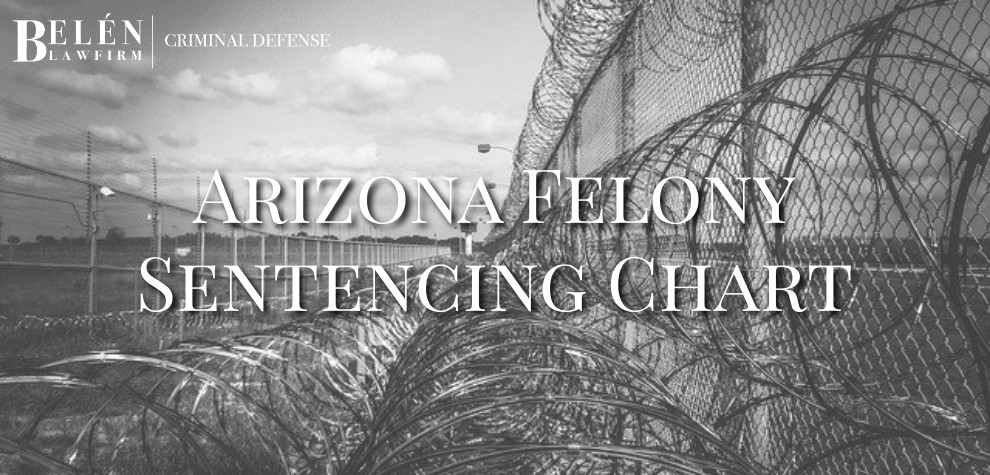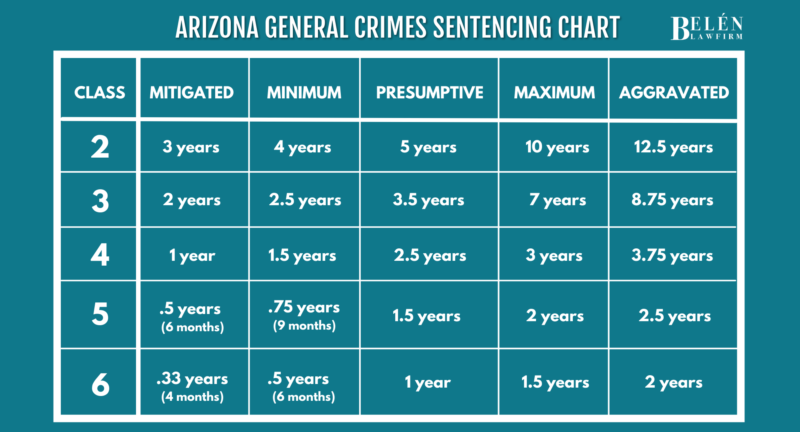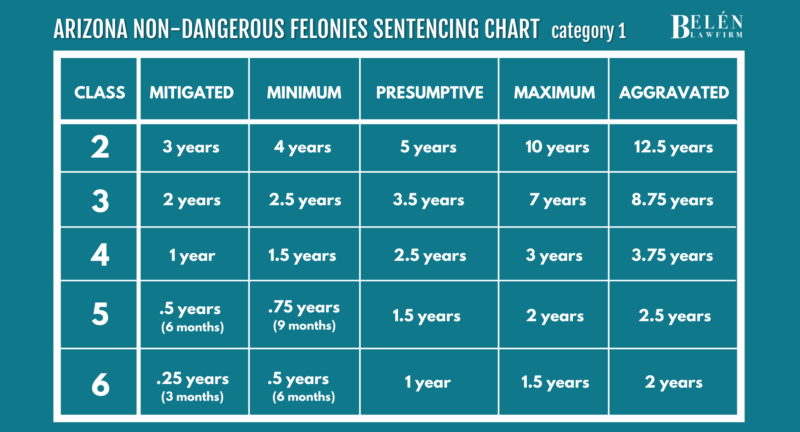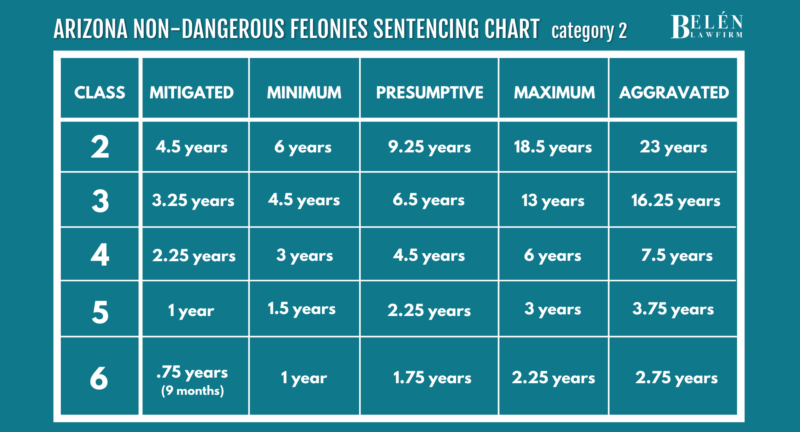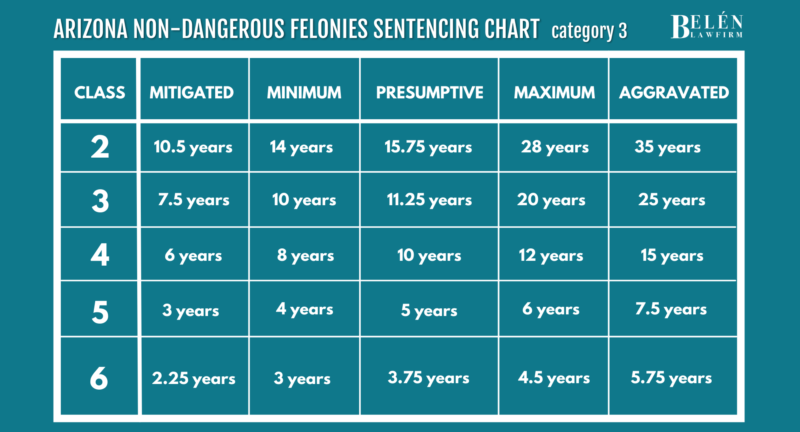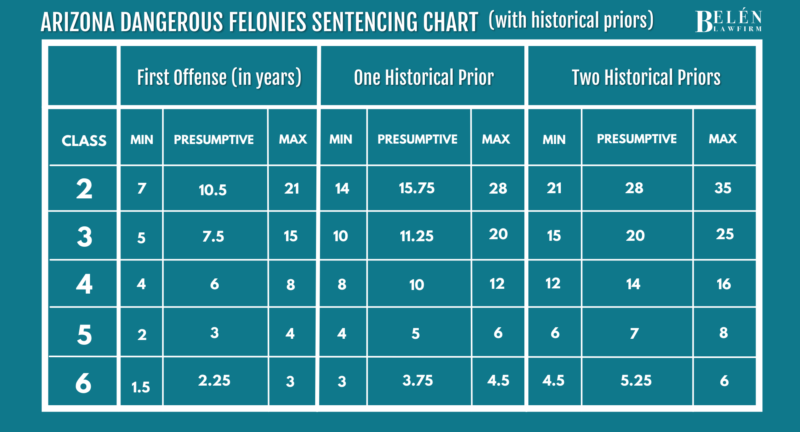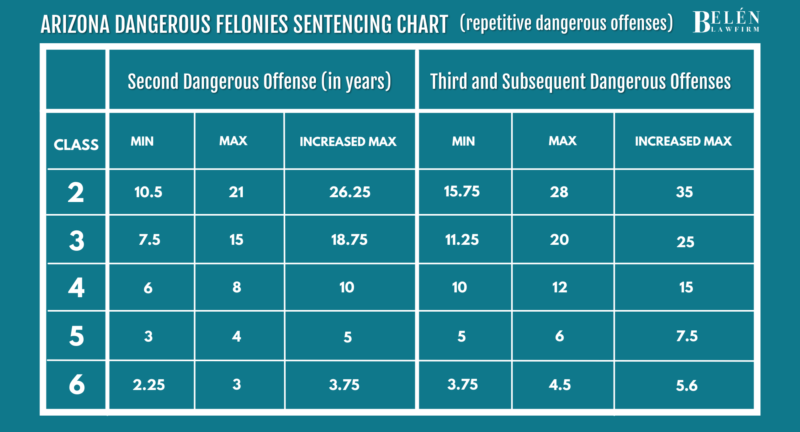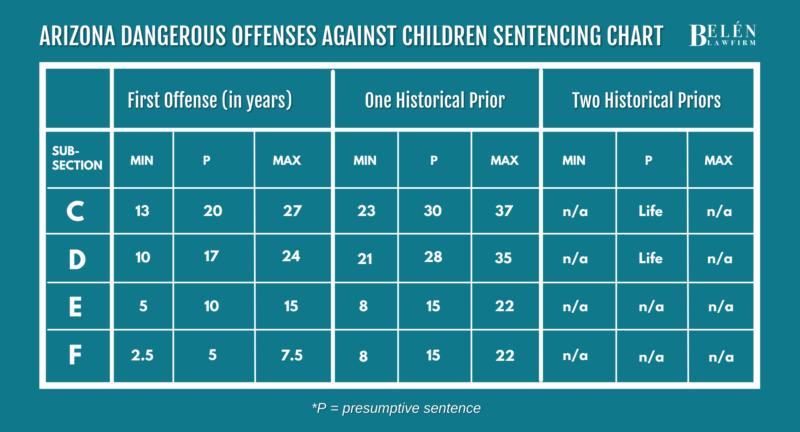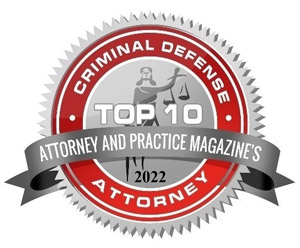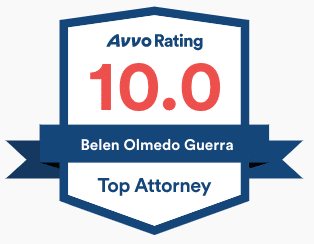The state of Arizona follows a mandatory sentencing scheme for felony offenders. What this means is that when determining the sentence for a defendant, the judge will look at certain factors to see what range the crime falls into. The Arizona felony sentencing chart can help those convicted of a felony anticipate what punishment they may be up against.
At Belén Law Firm, our legal team has an extensive knowledge of Arizona’s sentencing laws and guidelines. If you find yourself in legal trouble and are curious as to what sentence you may be looking at, we’ve provided charts for each category below. Further, if you seek professional counsel and aggressive representation for your case to avoid these harsh sentences, reach out today by calling our 24-hour criminal defense team at 602-715-0908.
Arizona Sentencing Guidelines
The sentencing guidelines for regular felonies in Arizona fall under sections 13-702 and 13-703 of the Arizona Revised Statutes. Meanwhile, A.R.S. 13-704 covers dangerous offenses and 13-705 covers dangerous crimes against children.
As we mentioned before, there are multiple factors that a judge must consider to establish what categories criminal offenses fall into. The factors that a judge will look at include whether the crime was a dangerous or non-dangerous offense, the defendant’s age, whether the defendant has any historical priors, and whether the crime was a repeat or first offense.
In the state of Arizona, first-degree murder and second-degree murder are the only crimes charged as Class 1 felonies. Class 1 felonies are not included in the Arizona felony sentencing chart. First-degree murder charges in Arizona are punishable by life in prison or the death penalty. Second-degree murder charges in Arizona are punishable by anywhere from 16 years to life imprisonment.
A dangerous felony is one that is a serious and violent offense. Dangerous crimes possess certain aggravating factors, which in turn leads to an aggravated sentence. In addition to both first and second-degree murder, these charges include:
- Manslaughter
- Aggravated assault resulting in serious injury
- Sexual assault
- Sexual conduct with a child below the age of 15
- Dangerous crimes against children
- Child prostitution
- Arson of an occupied structure
- Armed robbery
- First-degree burglary
- Kidnapping
Sentencing for dangerous crimes depends on whether the felony was a first or repeat offense.
What are the Circumstances that Allow a Judge to Find Either Aggravated or Mitigated Sentences in Felony Sentencing?
For defendants with a first offense, non-dangerous felony, both mitigating factors and aggravating factors are looked into. To reduce a sentence below the minimum sentence, the defendant must prove at least two mitigating factors. Mitigating factors may include the defendant’s age and the role he or she played in the crime. Likewise, to increase the sentence beyond the maximum sentence, two aggravating factors must be present. Aggravating factors may include the age of the victim, whether a deadly weapon or dangerous instrument was involved, and whether or not an accomplice was present at the occurrence of the crime.
AZ Sentencing Chart
GENERAL CRIMES
With the exception of certain drug convictions, anyone convicted of a first offense, non-dangerous felony is eligible for probation. The sentencing chart for general crimes includes the class of the offense, the mitigated prison sentence, mandatory minimum, presumptive sentence, mandatory maximum, and aggravated prison sentence. The sentencing chart is as follows:
NON-DANGEROUS FELONIES
The sentencing chart for non-dangerous felony offenses can be broken down into 3 separate charts based on historical prior felony convictions. Each chart includes the class of the non-dangerous offenses, mitigated sentence, mandatory minimum, presumptive sentence, mandatory maximum, and aggravated sentence. Category 1 represents one prior conviction, Category 2 represents two prior convictions, and Category 3 represents three prior convictions. The non-dangerous felonies chart is as follows:
DANGEROUS OFFENSES
Dangerous felony offenses also have different sentencing guidelines based on the number of previous convictions. Below, we’ll provide two charts. The first is for dangerous offenses with historical priors. A historical prior is any Class 3 felony conviction committed within 10 years of the date of the current dangerous offense. Keep in mind that this does not mean a prior felony conviction of a dangerous offense. This chart is broken down into First Offense, One Historical Prior, and Two Historical Priors.
The second chart is for repetitive dangerous offenses. It includes sentencing ranges for the Second Dangerous Offense and Third and Subsequent Dangerous Offenses.
Here are the Arizona felony sentencing charts for dangerous felonies with historical priors and dangerous repetitive offenses:
DANGEROUS OFFENSES AGAINST CHILDREN
Arizona punishes crimes against children much more severely than it does other felonies. They provide a completely separate guideline for the sentencing of these felonies. Dangerous offenses against children include, but are not limited to, the following:
- Sexual exploitation of a minor
- This means the defendant knowingly created, possessed, sold, bought, stored, or transported child pornography.
- Commercial sexual exploitation of a minor
- This includes the act of knowingly coercing a minor to engage in sexual acts or behaviors like prostitution or pornography.
- Luring a minor for sexual exploitation
- Furnishing harmful items to a minor
- Sexual conduct with a minor
- Molestation
- Aggravated assault against a minor that results in serious physical injury or involves a deadly weapon
The next chart represents the guidelines for dangerous offenses against children, including First Offense, One Historical Prior, and Two Historical Priors. You’ll notice that subsections A and B are not provided in the chart. Subsection A carries a sentence of life in prison. Subsection B carries the possibility of a life sentence with a minimum of 13 years, presumptive 20 years, and a maximum of 27 years. These subsections might include crimes such as Arizona sexual assault or attempted murder of a minor under the age of 12.
You’ll also notice that once the defendant reaches two historical prior convictions, they may only fall into subsections C and D. The presumptive sentence is life in prison, with no possibility of mitigating factors nor aggravating factors and no mandatory minimum or maximum provided. Here is the Arizona felony sentencing chart for dangerous offenses against children:
Contact Phoenix Criminal Defense Attorney Belén Today
If you have been charged with a felony and seek representation, or if you simply have questions regarding the Arizona felony sentencing chart, contact Belén Olmedo Guerra today. Belén offers aggressive defense for those accused of even the most serious felonies. For a professional and dedicated criminal attorney in Phoenix, AZ, you need Belén Law Firm. Call 602-715-0908 or visit our website to schedule your free consultation.

